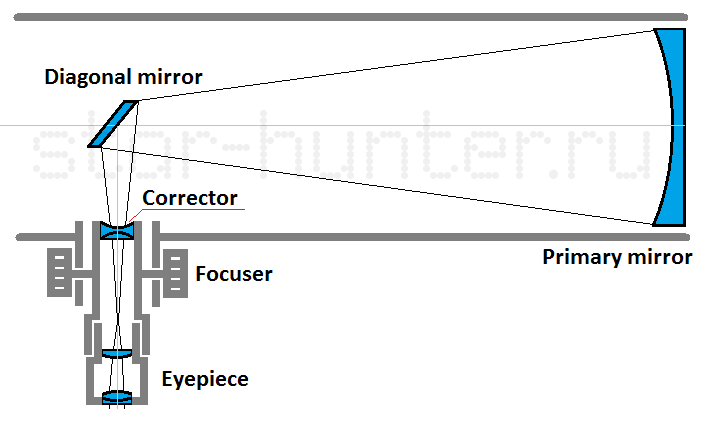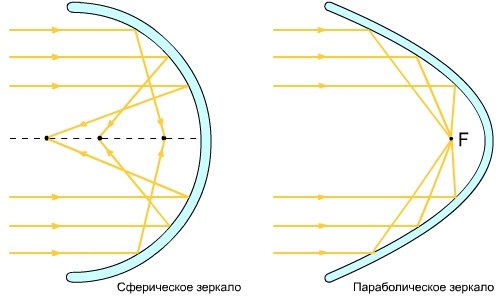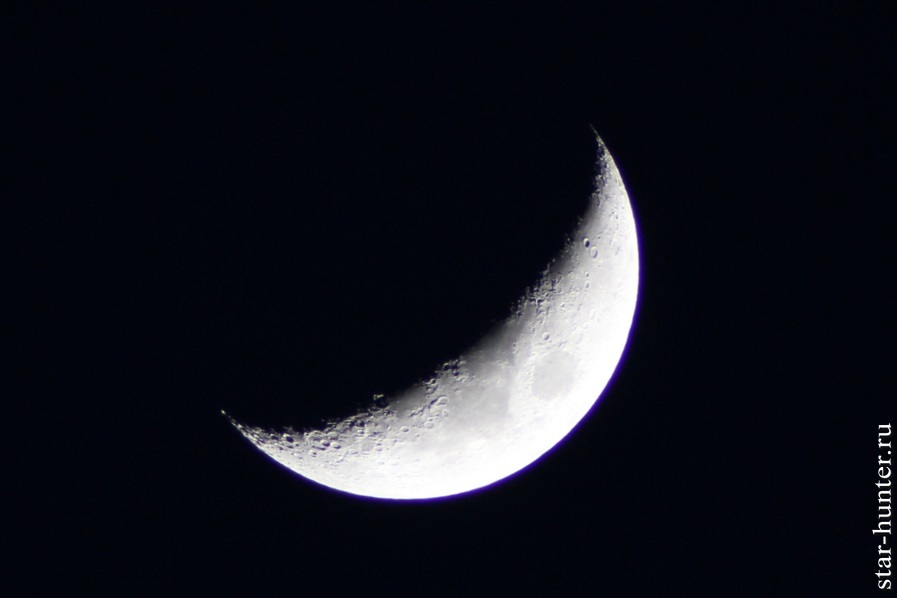
This list contains models of telescopes that, in my opinion, have serious shortcomings in the design, optical design or features of use, and which are not suitable for beginners. This black list based on my personal experience using various telescopes. Sellers in stores can either be silent about these shortcomings, or simply not be aware of them. In order to protect novice astronomy lovers from shops and sellers that’re soaring up the rubbish, I wrote this article.
Of course, this list is for advisory purposes only, and the final choice of telescope is still up to the buyer.
The main part of the list consists of the so-called “Newtons with corrector.” Their design uses a fast mirror of spherical shape and a small corrector lens, correcting the distortions of the main mirror. Unfortunately, the corrector does not always work well, so the image at medium and high magnification can be blurred, surrounded by highlights and halos. In principle, such a telescope can be fixed, however, it is hardly possible for a beginner amateur in astronomy.

Therefore, the right choice would be a telescope with either a spherical mirror and a long tube, or with a parabolic mirror. Remember – the tube length of the Newton’s mirror telescope system is approximately equal to the focal length. If the focal length is declared 1000 mm, then the tube should be about 1000 mm long. If the tube is short, and the focal length is stated large – then there must be a corrector in it. If the telescope’s tube is short, but the focal length seems to be small — be careful anyway — you can put a spherical mirror in such telescopes.

At the same time, there are a number of telescopes of other optical systems that are equipped with an corrector, but it copes with its task. These are the telescopes of the Maksutov-Kassegren, Schmidt-Cassegrain, Maksutov-Newton, Schmidt-Newton, Klevtsov systems. Telescopes of the Maksutov-Cassegrain, Schmidt-Cassegrain and Klevtsov systems are distinguished by a short tube and a long focal length – this is normal. Such telescopes can be acquired without fear, although there is some variation in the quality of optics.
There are also specialized coma correctors that are inserted into the telescope focuser. Coma is a type of aberration in which the stars at the edges of the field of view look like birds (V). Coma corrector are usually used with Newton’s high-aperture parabolic telescopes (Sky-Watcher BKP150750EQ3-2, Sky-Watcher BKP2001EQ5) either in visual or in photographic mode. An example of coma corrector is Baader MPCC II, Televue Paracorr II.
The second part of the blacklist is lens achromat telescopes with high focal ratio (1:4…1:6), also called fast achromats. Lens telescopes are characterized by chromatic aberration — a colored halo surrounding bright objects (the moon, planets). The longer the focal length of the lens telescope with the same lens diameter, the weaker and smaller the chromatic halo. Fast achromates are suitable for specialized applications (observations of galaxies, nebulae, clusters with a small magnification,observation of terrestrial objects), but such telescopes are not recommended for observations of planets. Chromatism can be reduced or eliminated with a yellow light filter or special filters such as Baader Fringe Killer, but this will distort the natural color – the objects acquire a yellowish tint. Also, chromatism is not too noticeable when observed by Mars and Saturn. For astrophotography of gas nebulae with fast achromats, the CLS filter can be useful – it cuts off purple halos, and reduces the city light pollution. Also, fast achromats are quite suitable for narrowband capturing in the line of hydrogen (H-alpha) and oxygen (OIII). Mirror and mirror-lens telescopes, as well as apochromatic refractors, haven’t chromatism.


But fast achromats also have some advantages – a large field of view and compact size. For camping or balcony use, they are more convenient than telescopes with long tubes, and due to the large field of view, they can be successfully used as a wide-angle instrument when observing dim objects (galaxies, nebulae, star clusters).

Also in the second part of the black list are telescopes of too small diameter – less than 60 mm. Yes, they will show something (craters on the moon, for example), but in fact they are “toys”. It is better to add and take a telescope with a lens of 70 mm or more. I personally encountered cases when parents came to the store with their 15-year-old son behind the telescope “no more than 50 dollars” and really wanted to buy such a toy telescope for a schoolboy. Such a telescope will generally discourage the desire to get involved in astronomy (as in the “telescope can not see anything”).
Also, I do not recommend telescopes on too flimsy and unstable mounts. Image stability is very important for successful astronomical observations, since with constant shaking it is not possible to explore the object in more detail. Unfortunately, most telescopes on a complete mount shake when focusing, when touching a optical tube or from the wind. This may be quite enough for visual observations, however, some models of telescopes come in different mounts. For example, Sky-Watcher BK1149EQ1 and Sky-Watcher BK1149EQ2 with identical optical tubes differ in mounting and price. Mount EQ2, although not very stable, and payload capacity is still better than the EQ1. If there is a choice between two similar optical tubes, but with different mounts, then it is better to take a mount with better payload capacity. Another example is the Celestron PowerSeeker 80 EQ and Sky-Watcher BK809EQ2. The optical tubes are identical, and the mounts are different and Sky-Watchers’ mount more stable.

Bad reflecting and catadioptric telescopes:
Bresser Pluto 114/500 EQ – fast spherical mirror
Bresser Pluto II 114/500 EQ (carbon) – fast spherical mirror
Bresser Pollux 150/1400 EQ2 (carbon) – corrector
Bresser Pollux 150 1400 – Corrector
Bresser Junior Dobson 76/350 – fast spherical mirror
Bresser National Geographic 114/500 – fast spherical mirror
Bresser Spica 130/1000 EQ3 — corrector
Bresser National Geographic 130/650 EQ — fast spherical mirror
Celestron FirstScope 76 – fast spherical mirror
Celestron Powerseeker 114 EQ is a very weak mount, although the pipe is quite good in optics. I advise you to pay attention to analogues with a stronger mount – Sky-Watcher BK1149EQ2, Meade Polaris 114.
Celestron Powerseeker 127 EQ – Corrector
Celestron Firstscope 114EQ Compact – Corrector
Celestron AstroMaster 114 EQ – Corrector
Celestron Astromaster 130 EQ, Celestron AstroMaster 130EQ-MD – fast spherical mirror
Celestron 114LCM – Corrector
Celestron NexStar N 114/1000 SLT GoTo – Corrector
Celestron Astromaster 76 EQ – everything is fine with optics, but the optical tube is not in the rings – it’s very hard to watch! It is necessary to purchase fixing rings.
Celestron EXPLORASCOPE 114AZ TELESCOPE – Corrector
Dicom N750150-EQ3 Nibiru 750 × 150-EQ – fast spherical mirror, weak mount
DICOM Nibiru 800 × 203-EQ4 (N800203-EQ4) – fast spherical mirror
DOFFLER T1141000 – Corrector
Fancier F1400150EQIII-A Corrector
Fancier F800203EQIV – fast spherical mirror
iOptron SmartStar-G-N114 – corrector.
JJ-Astro Astroman AutoTrack 114 × 500 – fast spherical mirror
Kon-Tiki 76/100 – fast spherical mirror
Konus KonusMotor 130 – corrector
Konus KonusMotor 500 – fast spherical mirror
Levenhuk LabZZ D1 – fast spherical mirror
Levenhuk Skyline 120 × 1000 – corrector
Levenhuk Skyline 114 × 1000 EQ – Corrector
Levenhuk Strike 100 PLUS – fast spherical mirror (residual spherical aberration)
Levenhuk Strike 120 PLUS – fast spherical mirror (residual spherical aberration)
Levenhuk Astro L220 EQ – possibly a fast spherical mirror
Levenhuk Blitz 114s PLUS – corrector
Levenhuk Blitz 203 PLUS – fast spherical mirror
Meade StarNavigator 114 – Corrector
Meade DS-2130 Corrector
Meade DS-2114 – Corrector
Meade Polaris 114- Corrector
Meade Polaris 127 – Corrector
Meade Polaris 130 – fast spherical mirror, thick spider
Meade StarNavigator 130 mm – fast spherical mirror
82mm MEADE EclipseView – fast spherical mirror
National Geographic 76/350 Dobson – fast spherical mirror
National Geographic 114/500 fast spherical mirror, most likely
NATIONAL GEOGRAPHIC NEWTON TELESCOPE 130/650 SPH – fast spherical mirror, most likely
Omegon 150/750 EQ-3 – fast spherical mirror, most likely
Omegon 114/900 EQ-1 – weak mount.
Orion SpaceProbe 3 – everything is fine with optics, but the optical tube is not in the rings – it’s very hard to watch! It is necessary to purchase fixing rings.
Pentaflex Reflector 130/1000 GOTO – Corrector
The Pentaflex Reflector 114/500 EQ1 is most likely a fast spherical mirror
RBT T800203 – fast spherical mirror
RBT T1141000 – Corrector
Seben 1000-114, also from the magazine “COLLECT YOUR TELESCOPE” (De Agostini) – corrector
Seben Big Boss 1400-150 EQ3 – corrector
Sky-Watcher BK Dob 76 – fast spherical mirror
Sky-Watcher BK1141EQ1 – Corrector
Sky-Watcher BK1145EQ1 – fast spherical mirror
Sky-Watcher Skyhawk-114/1000 EQ-1 – corrector
Sky-Watcher BK1149EQ1 – weak mount, pay attention to Synta (Sky-Watcher) BK1149EQ2.
SIGETA ME-150 150/750 EQ3 – fast spherical mirror (most likely)
Sigeta ME-200 – fast spherical mirror
Sigeta ME-200 EQ4 – fast spherical mirror
Sturman F500114 EQ3-M – Corrector
STURMAN 1400150 – Corrector
Sturman HQ 1000114 EQ1 – Corrector
STURMAN F900114 EQIII – weak mount
Sturman 750150 – fast spherical mirror
Synta NBK130650EQ2 – fast spherical mirror
Synta BK1149EQ1 – weak mount, it is better to pay attention to Sky-Watcher BK1149EQ2.
Synta Sky-Watcher Dob 76/300 Heritage – fast spherical mirror
Tasco Galaxsee 144500 – corrector
TS Optics Starscope 150 / 750mm Newton – fast spherical mirror
TS Starscope1306 – 130/650 – it is possible that thefast spherical mirror
TS Newtonian 150 / 1400mm on Mount EQ3-1 Megastar1550 – Corrector
Konus motor-130 corrector
Veber PolarStar 1000/114 EQ – Corrector
Veber PolarStar 1400/150 EQ – corrector
Veber PolarStar 1400/150 EQ – Corrector
Veber 1400/150 EQ – Corrector
Veber PolarStar 800/203 EQ – fast spherical mirror
Tal-120 – corrector, lack of adjustment of the main mirror.
Bad refracting telescopes
Bresser Messier AR-152S / 760 (EXOS-2 / EQ5) – fast achromat
Bresser Junior 50/600 silver – weak mount
Bresser RB-60 60/700 – weak mount
Bresser Junior Lunar 60/700 AZ – weak mount
Bresser National Geographic 70/350 Go To – fast achromat, small diameter at high cost
Bresser Junior 70/350 ETX-70 – fast achromat, small diameter at high cost
Bresser Junior 60/350 GOTO with case – small diameter with high cost
Bresser AR-102/600 EQ-3 AT3 Refractor – fast achromat
Celestron PowerSeeker 50AZ – weak mount, incomplete coating of optics, small diameter
Celestron PowerSeeker 50 TT- weak mount, incomplete coating of optics, small diameter
Celestron Travel Scope 70 – fast achromat, instead of mount – photo rod
Celestron Travel Scope 50 – small diameter, instead of mount – photo pole
Celestron Powerseeker 60 EQ – a small field of view, a purely lunar-planetary telescope.
Celestron Powerseeker 80 EQ is a very weak mount, although the optical tube is quite good in optics. I advise you to pay attention to the analog with a stronger mount – Sky-Watcher BK809EQ2.
Celestron NexStar 102 GT-SA fast achromat
Celestron NexStar 102 SLT – fast achromat
Celestron INSPIRE 100AZ REFRACTOR TELESCOPE – fast achromat
DOFFLER T50600 – weak mount, small diameter
DOFFLER T40070 – fast achromat
Eastcolight 9920 – some kind of camera toy
Eastcolight 32021 – small diameter, unstable mount
Eastcolight 3066 – small diameter, unstable mount
Eastcolight 2380 – small diameter, unstable mount
FANCIER F40070M – fast achromat, weak mount, eyepieces 0.965″
iOptron Astroboy – fast achromat
iOptron SmartStar-G-R80 – fast achromat
iOptron SmartStar-A-R80 – fast achromat
Levenhuk Skyline 80×400 AZ – fast achromat
Levenhuk Skyline Travel 70 – fast achromat, flimsy mount
Levenhuk Strike PLUS 90 – fast achromat
Levenhuk SkyMatic 105 GTA – fast achromat
Levenhuk Fixiki – unstable mount, no micrometer screws, overpriced
Levenhuk LabZZ T1 – unstable mount, small diameter, poor coating
Levenhuk LabZZ T2 – unstable mount, small diameter, poor coating
Levenhuk LabZZ MT2 – toy mount, small diameter, poor coating
Levenhuk LabZZ MTV3 – toy mount, small diameter, poor coating
Levenhuk Blitz 80s PLUS – fast achromat
Meade ETX-80 – fast achromat
Meade Infinity 80 mm – fast achromat
Meade Infinity 102 mm – fast achromat
National Geographic Refractor 70/350 StarTracker GOTO – fast achromat
Orion AstroView 100mm EQ – fast achromat
Orion AstroView 120ST EQ – fast achromat
Paralux Lunette 70/350 – fast achromat
RBT T40070 – fast achromat
RBT T50600 – weak mount without micrometer screws
Sigeta Tucana 70/360 with case – fast achromat, weak mount.
Sigeta Volans 70/400- fast achromat, weak mount.
Sigeta Libra 80/400 – fast achromat
Sky-Watcher BK804AZ3 – fast achromat
Sky-Watcher BK1206AZ3 – fast achromat
Sky-Watcher 1206EQ3-2 – fast achromat
Sky-Watcher BK 1025 AZ3 – fast achromat
Sky-Watcher 1025 EQ1 – fast achromat on deadly EQ1
Sky-Watcher 150750 OTA (WHICH REFRACTOR) – fast achromat
Sturman HQ 40080 AZ3 – fast achromat
STURMAN HQ2 40070AZ- fast achromat
Sturman F600102 EQ4 – fast achromat
Synta protostar 50 AZ – – weak mount, incomplete coating of optics, small diameter
Veber 900/90 EK – weak mount, built-in wrap uncoated prism, incomplete coating of the objective lens.
Veber PolarStar 900/90 EQ8 – weak mount, built-in wrapping uncoated prism, incomplete coating of objective lenses.
Veber 900/90 AZ – weak mount, built-in wrapping uncoated prism, incompletecoating of the objective lens.
Veber 700/70 AZ – weak mount, built-in wrap uncoated prism, incomplete coating of the objective lens.
Veber PolarStar 700/70 AZ – weak mount, built-in wrapping uncoated prism, incomplete coating of objective lenses.
Veber 700/70 EK – the built-in turning not uncoated prism.
Veber 400/80 Az – a weak mount, a built-in wrap uncoated prism, incomplete coating of the objective lens, fast achromat.
Veber F70060TXII in the case – a very weak mount.
Veber 350/60 – fast achromat, weak mount, built-in wrapping uncoated prism.
Catadioptrics (Mirror lens)
Deepsky Mak 60 – the aperture is shielded to 40 mm with a second blend on the secondary mirror. After removing the second hood, the entire aperture is working.
Celestron C70 Mak is a telescope, not very suitable for astronomical observations.
Veber MAK 1000/90 – telescope, for astronomical observations not very suitable.